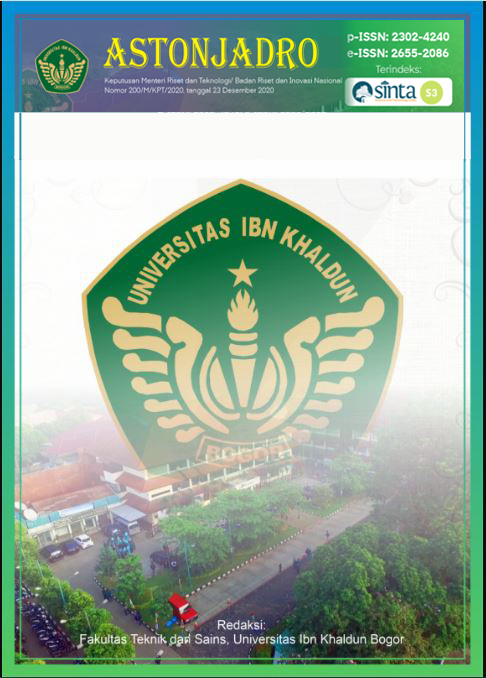Resource Leveling Optimization Using Different Objective Functions on Building Project
Keywords:
fluctuation; optimization; labor; resource leveling; SOS.Abstract
One of the problems that often occur in allocating labor is fluctuations arising from the uneven allocation of labor, so resource leveling optimization is needed to avoid these problems. This study investigates the impact of five objective functions to determine which objective function can produce an efficient labor histogram and determine the effect of resource leveling on changes in labor cost fluctuations based on case studies. The research was conducted using the symbiotic organisms search (SOS) algorithm. The results of this study show that objective function 4 (the minimum amount of the sum of the squared deviations in the use of resources between time intervals) is more effective than other objective functions by producing the most significant average increase in fitness value of 61.64% and can produce a smoother labor allocation histogram compared to other objective functions. Resource leveling also affects cost fluctuations, with a decrease in efficiency of 47%, so that it can improve project implementation efficiency and effectiveness.
References
Cheng, M. Y., & Prayogo, D. (2014). Symbiotic Organisms Search: A new metaheuristic optimization algorithm. Computers and Structures, 139, 98–112.
Cheng, M. Y., Tran, D. H., & Hoang, N. D. (2016). Fuzzy clustering chaotic-based differential evolution for resource leveling in construction projects. Journal of Civil Engineering and Management, 23(1), 113–124.
Cheng, M.-Y., Prayogo, D., & Tran, D.-H. (2016). Optimizing Multiple-Resources Leveling in Multiple Projects Using Discrete Symbiotic Organisms Search. Journal of Computing in Civil Engineering, 30(3).
Damci, A., Arditi, D., & Polat, G. (2016). Impacts of different objective functions on resource leveling in Line-of-Balance scheduling. KSCE Journal of Civil Engineering, 20(1), 58–67.
Damci, A., & Polat, G. (2014). Impacts of different objective functions on resource leveling in construction projects: A case study. Journal of Civil Engineering and Management, 20(4), 537–547.
Ezugwu, A. E., & Prayogo, D. (2019). Symbiotic Organisms Search Algorithm: theory, recent advances and applications. Expert Systems with Applications, 119, 184–209.
Huang, H.-H., Huang, C.-H., & Wen, P. (2015). Solving Multi-Resource Constrained Project Scheduling Problem using Ant Colony Optimization. Journal of Engineering, Project, and Production Management, 5(1), 2–12.
Sears, K.S, Sears, G.A., & S. Clough, R.H. (2008). Construction Project Management, a Practical Guide to Field Construction Management. Publisher John Wiley & Sons Inc.
Li, H., Xiong, L., Liu, Y., & Li, H. (2018). An effective genetic algorithm for the resource levelling problem with Generalised Precedence Relations. International Journal of Production Research, 56(5), 2054–2075.
Loleh, M. A., Inkirawang, R. L., & Mangare, J. B. (2022). Perataan Sumber Daya Tenaga Kerja Pada Proyek Konstruksi Bangunan Gedung Menggunakan Microsoft Project (Studi Kasus Pembangunan Lanjutan Aula Dan Gedung RKB SMA Negeri 1 Kawangkoan). Jurnal Sipil Statik, 10(1), 47–56.
Mahendra, I. K., Suardika, I. N., & Yuni, N. K. S. E. (2022). Perbandingan Penjadwalan Proyek Dengan Dan Tanpa Resource Leveling. 01(01), 499–507.
Prayogo, D., Cheng, M. Y., Wong, F. T., Tjandra, D., & Tran, D. H. (2018). Optimization model for construction project resource leveling using a novel modified symbiotic organisms search. Asian Journal of Civil Engineering, 19(5), 625–638.
Prayogo, D., & Kusuma, C. T. (2019). Optimization of resource leveling problem under multiple objective criteria using a symbiotic organisms search. Civil Engineering Dimension, 21(1), 43–51.
Retno, D. P., Astuti, A., & Tamimi, Z. (2018). Analisa Penggunaan Sumber Daya Manusia Dengan Metode Resource Leveling Pada Pelaksanaan Proyek Konstruksi (Studi Kasus: Proyek Pembangunan Ruang Kelas Baru Ponpes Daarun Nahdah Thawalib Bangkinang). Jurnal Saintis, 18(1), 39–47.
Tran, D.-H., Cheng, M.-Y., & Pham, A.-D. (2016). Using Fuzzy Clustering Chaotic-based Differential Evolution to solve multiple resources leveling in the multiple projects scheduling problem. Alexandria Engineering Journal, 55, 1541-1552.
Yahya, A. R., & Abma, V. (2022). Analisis Kebutuhan Tenaga Kerja Dengan Menggunakan Metode Resource Levelling. Avaliable at Researchgate.
Zhang, H., & Yang, Z. (2018). Accelerated Particle Swarm Optimization to Solve Large-Scale Network Plan Optimization of Resource-Leveling with a Fixed Duration. Mathematical Problems in Engineering, 2018.
Downloads
Published
How to Cite
Issue
Section
License
Copyright (c) 2023 ASTONJADRO

This work is licensed under a Creative Commons Attribution-ShareAlike 4.0 International License.
Paper submitted to ASTONJADRO is the sole property of the Astonjadro Journal. Unless the author withdraws the paper because he does not want to be published in this journal. The publication rights are in the journal Astonjadro.ASTONJADRO
LICENSE
This work is licensed under a Creative Commons Attribution-ShareAlike 4.0 International License.
Based on a work at http://ejournal.uika-bogor.ac.id/index.php/ASTONJADRO













